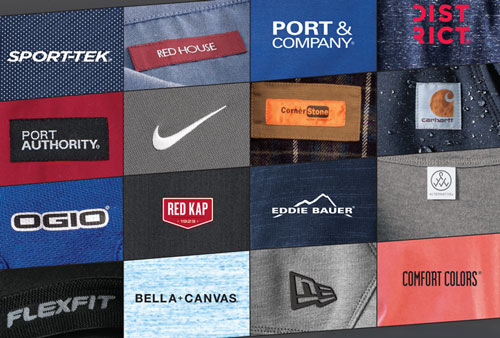Is Branded Clothing Really Better Because of the Fabric?
Is Branded Clothing Really Better Because of the Fabric?
Blog Article
The Significance of Sustainable Apparel: Exactly How It Impacts the Setting and Your Wardrobe
Lasting apparel is increasingly recognized for its vital role in lessening the environmental impact of the quick garment industry. By concentrating on eco-friendly materials and moral manufacturing methods, it attends to pressing ecological problems. This shift not only profits the world yet likewise influences consumer selections, leading to a much more thoughtful strategy to closet management. Recognizing these dynamics raises essential concerns about style's future and personal obligation fit it.
The Ecological Footprint of Fast Fashion

Advantages of Lasting Products
Lasting materials provide significant advantages, specifically via eco-friendly fabric choices that lessen environmental harm. These products also show durability and durability, lowering the requirement for frequent substitutes. As an outcome, they contribute to an extra sustainable style industry and advertise responsible customer behavior.
Eco-Friendly Textile Options
While the apparel industry has actually long been connected with quick fads and environmental harm, the rise of environment-friendly fabric selections presents a transformative opportunity. Sustainable materials such as organic cotton, hemp, and Tencel have actually gotten popularity because of their lower ecological influence. These materials are typically generated without unsafe pesticides and need much less water, lowering their carbon footprint - Branded Clothing. In addition, numerous environment-friendly textiles are naturally degradable, adding to a circular economic climate by reducing waste. Picking sustainable products not just supports eco responsible techniques but also promotes healthier communities. As consumers end up being more mindful of their acquiring power, the demand for environment-friendly fabrics encourages brands to introduce and take on even more sustainable production techniques, inevitably profiting the planet and future generations
Longevity and Longevity Advantages
Many consumers are increasingly acknowledging the durability and durability benefits of lasting materials in their clothes choices. Unlike conventional materials, sustainable materials such as organic cotton, hemp, and recycled polyester are engineered to hold up against damage, resulting in garments that last much longer. This decreased frequency of replacement not just conserves consumers money over time but additionally lessens waste created by rapid style. In enhancement, lasting clothes frequently employs environment-friendly production methods that improve textile stamina, adding to a reduction in the overall carbon impact. By purchasing long lasting garments, consumers can cultivate an extra lasting closet while enjoying top quality items that preserve their aesthetic and functionality with time. Durability and long life stand as crucial benefits of choosing lasting materials.
Lowering Waste With Sustainable Practices
Lowering waste in the fashion business can be attained with innovative methods such as upcycling and repurposing materials. In addition, embracing minimal closet strategies urges consumers to prioritize top quality over quantity, inevitably reducing clothing consumption. Together, these strategies add substantially to a much more sustainable apparel design.
Upcycling and Repurposing Products
Upcycling and repurposing materials have become innovative methods in the fashion business, changing discarded textiles right into valuable new items. This technique not just reduces waste however additionally urges creativity and uniqueness in garments design. By taking old garments and products, developers can create one-of-a-kind pieces that show personal style while minimizing the demand for new resources. Furthermore, upcycling typically calls for less energy and water compared to standard production procedures, considerably lowering the environmental footprint of fashion. As consumers end up being a lot more knowledgeable about sustainability, the appeal of upcycled clothing remains to climb, promoting a circular economic climate. Eventually, these methods add to an extra sustainable future, where fashion prioritizes environmental health over quick production and usage.

Minimalist Closet Strategies
As individuals increasingly look for to decrease their environmental influence, taking on minimal wardrobe methods has gotten traction as an efficient approach to lasting style. These approaches highlight top quality over quantity, encouraging consumers to curate a smaller collection of functional, long lasting clothing. By focusing on timeless pieces that can be mixed and matched, individuals can lower the regularity of purchases and ultimately lower waste.Additionally, minimalism advertises mindful consumption, prompting customers to assess the environmental and moral ramifications of their options. This method not just promotes an extra sustainable way of living however also streamlines daily decision-making regarding clothing. As people welcome minimal principles, they add to a fashion society that values sustainability and accountable consumerism, inevitably leading to an extra eco-conscious society.
The Duty of Honest Labor in Lasting Fashion
While many customers are progressively conscious of the environmental consequences of their garments options, the value of honest labor techniques in sustainable style can not be neglected. Moral labor incorporates reasonable incomes, risk-free working conditions, and respect for employees' rights, creating the backbone of liable fashion production. Brand names look at more info that prioritize ethical labor not just boost communities however also set a requirement for accountability in the industry.Moreover, the combination of moral methods cultivates transparency, allowing customers to make educated choices regarding their acquisitions. This practice contrasts greatly with quick style's unscrupulous labor models, which frequently focus on earnings over people. By supporting firms committed to ethical labor, consumers add to a system that values human dignity along with ecological sustainability. As a result, ethical labor is not simply an add-on; it is vital to the more comprehensive objective of lasting style, ensuring that the mission for eco-friendliness does not come with the expense of human rights.
The Impact of Lasting Garments on Carbon Emissions
Lasting clothing has the possible to considerably minimize carbon emissions connected with the apparel industry. Traditional garment manufacturing contributes notably to greenhouse gas exhausts, mostly due to energy-intensive production processes and making use of non-renewable sources. On the other hand, lasting fashion concentrates on eco-friendly products, such as organic cotton or recycled fibers, which frequently call for less energy to produce.Moreover, lasting brands tend to adopt extra effective manufacturing techniques, reducing waste and decreasing general exhausts. By prioritizing durability and classic style, lasting clothes urges customers to buy much less frequently, more decreasing the carbon impact related to overconsumption.Additionally, many lasting brand names are dedicated to transparency in their supply chains, allowing consumers to make enlightened options that align with their worths. Eventually, shifting in the direction of lasting garments can bring about a significant decrease in carbon exhausts, adding to a much healthier world and a much more sustainable future for the garment industry.
Supporting Local Economic Climates With Sustainable Selections
The shift toward lasting clothing not just addresses ecological problems but additionally significantly advantages local economic climates. By selecting lasting fashion, customers commonly sustain neighborhood craftsmens and small companies, enhancing neighborhood durability. These business typically operate a smaller range, prioritizing workmanship and honest techniques over mass production.Investing in locally made lasting garments fosters job production and boosts financial growth within communities. As consumers come to be extra familiar with the ecological effect of their purchases, they progressively seek products that mirror their worths. This demand encourages local producers to adopt sustainable practices, adding to a round economy.Moreover, sustaining local services decreases transportation exhausts, lining up with eco-conscious consumer habits. The interconnectedness of sustainable apparel and regional economic climates highlights the vital role that specific options play in promoting both financial and ecological health and wellness. By fostering these regional connections, neighborhoods can flourish while additionally working in the direction of a much more lasting future.
Transforming Your Storage Room: Tips for a Lasting Wardrobe
As people seek to minimize their environmental influence, changing a closet right into a sustainable closet becomes an important action. One efficient strategy is to review existing clothes, keeping just items that are used frequently which straighten with sustainability goals. Focusing on quality over quantity is essential; buying sturdy pieces from green brands can substantially decrease waste.Additionally, including second-hand products can rejuvenate a closet while decreasing environmental damage. Organizing garments swaps with friends or giving away extra things can further promote sustainability.When shopping, people ought to look for products that are organic, recycled, or biodegradable, and avoid quick style stores - Branded Clothing. Practicing conscious intake by thoughtfully considering each purchase can contribute to a much more sustainable way of life. By applying these tips, one can develop a wardrobe that mirrors individual design while sustaining environmental stewardship
Frequently Asked Questions
Exactly How Can I Determine Lasting Apparel Brands?
To determine sustainable clothing brands, one should research products made use of, look for certifications like Fair Profession, and check out the brand's transparency regarding their production processes, labor practices, and ecological influence, ensuring green and honest practices are prioritized.
What Are the Costs Associated With Lasting Style?
The expenses related to sustainable fashion can vary considerably. Greater manufacturing costs, honest sourcing, and eco-friendly materials commonly lead to boosted market prices, which might prevent some consumers while interesting ecologically conscious customers.
Can Sustainable Clothing Be Elegant and Stylish?
Lasting clothes can indeed try this site be elegant and trendy. Developers progressively prioritize cutting-edge materials and honest production techniques, proving that style and sustainability can coexist. Consumers currently have diverse choices that blend aesthetic appeals with environmental consciousness.
Just How Does Laundering Clothes Affect Their Sustainability?
Cleaning clothing greatly influences sustainability by consuming water and energy, adding to pollution, and creating microplastic release. Frequent washing can degrade textiles, reducing their life expectancy and enhancing the demand for replacements, inevitably exacerbating environmental worries.
What Is the Life-span of Lasting Clothing Compared to Quick Style?
The life-span of sustainable garments usually exceeds that of fast fashion products, commonly lasting a number of years because of high quality products and workmanship. In comparison, rapid style garments may weaken rapidly, demanding even more frequent replacements. Lasting garments is increasingly acknowledged for its websites crucial duty in reducing the environmental effect of the rapid style industry. While lots of customers are increasingly mindful of the environmental repercussions of their garments selections, the importance of honest labor methods in sustainable fashion can not be overlooked. Branded Clothing. Lasting apparel has the possible to substantially decrease carbon emissions associated with the style market. In comparison, lasting style focuses on green products, such as natural cotton or recycled fibers, which often call for less power to produce.Moreover, sustainable brands have a tendency to take on extra reliable manufacturing practices, decreasing waste and reducing general emissions. By focusing on longevity and ageless design, lasting apparel motivates customers to get less often, additional decreasing the carbon footprint linked with overconsumption.Additionally, lots of sustainable brand names are committed to transparency in their supply chains, making it possible for customers to make educated selections that line up with their values
Report this page